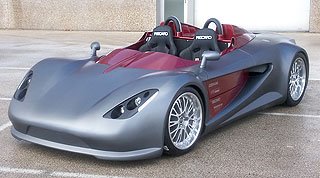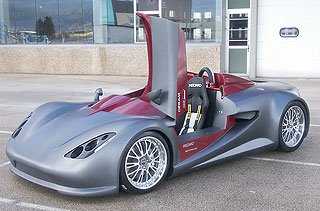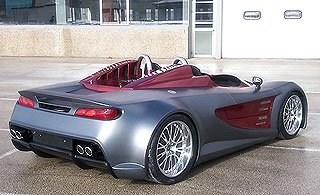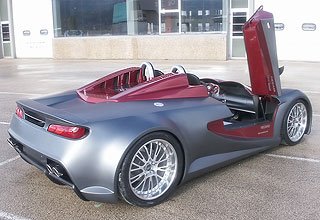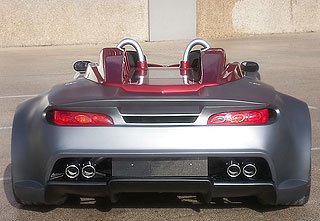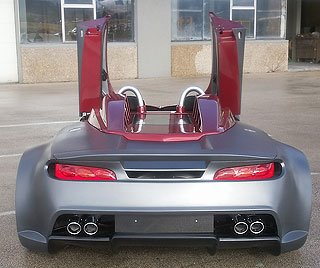The 77th Geneva Motor Show offered an amazing view into the future.
Showing posts with label Geneva Auto Show. Show all posts
Showing posts with label Geneva Auto Show. Show all posts
Saturday, March 17, 2007
Friday, March 16, 2007
2007 Geneva Auto Show Wrap: beON Concept Aims To Fix "Unappealing" Image of Hybrids
GENEVA — The class assignment was intriguing: Start with the premise that hybrid vehicles have a "somewhat unappealing image" and come up with a vehicle that is more "emotional" than intellectual. The result is the beON hybrid, which made its debut at this month's Geneva auto show.
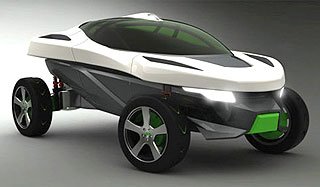
 The beON is the brainchild of students at the Istituto Europeo di Design (IED) of Turin, Italy. They were directed by Luca Borgogno, a Pininfarina designer, and Carsten Astheimer, head of design at the Brunswick Boat Group. The beON is a two-seat off-road sports car with a sunroof. It is powered by a hybrid thermal-electric engine connected to a hydraulic transmission system located within each wheel hub. Its creators say this futuristic setup guarantees "excellent off-road performance" and also means traditional disc and caliper braking can be eliminated.
The beON is the brainchild of students at the Istituto Europeo di Design (IED) of Turin, Italy. They were directed by Luca Borgogno, a Pininfarina designer, and Carsten Astheimer, head of design at the Brunswick Boat Group. The beON is a two-seat off-road sports car with a sunroof. It is powered by a hybrid thermal-electric engine connected to a hydraulic transmission system located within each wheel hub. Its creators say this futuristic setup guarantees "excellent off-road performance" and also means traditional disc and caliper braking can be eliminated.

 The beON is the brainchild of students at the Istituto Europeo di Design (IED) of Turin, Italy. They were directed by Luca Borgogno, a Pininfarina designer, and Carsten Astheimer, head of design at the Brunswick Boat Group. The beON is a two-seat off-road sports car with a sunroof. It is powered by a hybrid thermal-electric engine connected to a hydraulic transmission system located within each wheel hub. Its creators say this futuristic setup guarantees "excellent off-road performance" and also means traditional disc and caliper braking can be eliminated.
The beON is the brainchild of students at the Istituto Europeo di Design (IED) of Turin, Italy. They were directed by Luca Borgogno, a Pininfarina designer, and Carsten Astheimer, head of design at the Brunswick Boat Group. The beON is a two-seat off-road sports car with a sunroof. It is powered by a hybrid thermal-electric engine connected to a hydraulic transmission system located within each wheel hub. Its creators say this futuristic setup guarantees "excellent off-road performance" and also means traditional disc and caliper braking can be eliminated.
Wednesday, March 14, 2007
2007 Italdesign Giugiaro Vadho
(from Italdesign Press Release) BMW hydrogen power.
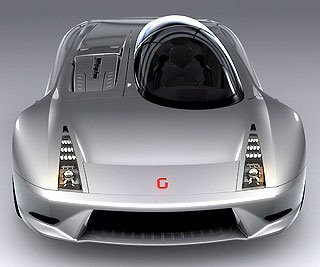 Once again, Geneva offers the opportunity to develop research on form and contents that break away from the industrial approach that Italdesign Giugiaro adopt daily in order to supply their worldwide clients with designs that best suit their markets.
Once again, Geneva offers the opportunity to develop research on form and contents that break away from the industrial approach that Italdesign Giugiaro adopt daily in order to supply their worldwide clients with designs that best suit their markets.
The challenging “diversion” this year represents a niche theme meant to be heatedly discussed: a super-sporty extreme two-seater fuelled by hydrogen to meet the increasingly pressing need to promote and develop alternative and environment friendly propulsion systems and to explore the potential challenge offered to design by a more flexible “displacement” of the chassis lay-out in new engine, mechanical, and electronic equipments.
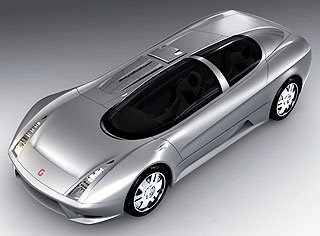
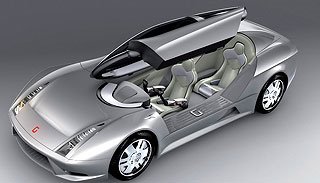
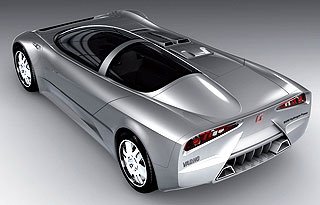
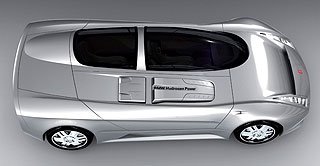
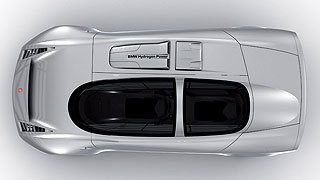
The decision to remove the steering wheel took Italdesign Giugiaro to the creation of a highly innovative driving system: two joysticks are fixed on the armrests of the pilot’s seating and pedals unit, where all elements can be adjusted and customized to the driver’s needs. The armrest/joystick/ electrical pedals and seating unit is not connected to the chassis. This and its by-wire impulses system allow to adapt the different versions with right, centre and left driving with no onerous works once the vehicle should go into production. This system presents design - construction and performance - characteristics that prompted Italdesign Giugiaro to patent it.
VAD.HO is meant to be an open “work in progress": it has been positively welcome by BMW that accepted to provide for it their series 7 12 cylinders hydrogen powered engine.
One curiosity: the acronym “VAD.HO” is a play on words that uses the name of the Vadт industrial area in Moncalieri where Italdesign Giugiaro headquarters have been located since 1974, and also refers to the hydrogen propulsion system adopted for the vehicle (vado - or “I go" in Italian - on H).
The cockpit
This model immediately puts all its ambitions on the line: a longitudinal cockpit in polycarbonate emerges on the left-hand side while the right side houses the engine and hydrogen propulsion
devices in the centre. The two Argonauts are seated in tandem in the fuselage, settled into a comfortable and super-equipped ergonomic cockpit.
The joysticks are fixed in the armrests that are integral with the pilot seat (the left armrest can be raised to facilitate getting in and out of the vehicle).
Designers and technicians believe that this solution facilitates naturally comfortable – and therefore stable and precise – steering manoeuvres and activation of all the joystick commands, including driving and secondary devices such as entertainment and other options.
In order to facilitate manoeuvres in curves without having to twist or rotate your wrists, the joysticks were conceived with two grips that help the necessary movements. The joystick moves back and forth along the armrest to ensure driver comfort, as well as the sliding pedal block that, hinged on the lower part, adjusts to the seat, which is in turn fixed to the chassis.
The control group is designed as an IT console with liquid crystal displays designed for aeronautic applications (EFIS - Electronic Flight Information Systems). The digital driving instrumentation is positioned centrally under the rear-view continual video monitors and the navigator; side video cameras project films externally. The surface occupied by the instrumentation is in any case limited, in order to allow the pilot maximum external visibility.
Access to IT data from the console is also available to the rear passenger by means of a dedicated joystick, similar to the driver's, and two monitors built into the back of the driver's seat. The faces of both pilot and passenger are filmed by video cameras and may appear on reciprocal monitors to enhance team interaction.
Thanks to video cameras installed in the frontal optical group, the driver can use the monitors either for parking radar and for an infrared effect for night-time driving, or interactive driving between the car and road infrastructures, when they become available.
Passengers get into the vehicle through two integrated doors/domes that are hinged lengthwise onto the structure and lift gull-wing style. The living space for the pilot and passenger are definitely comfortable because they were calculated at an "OSCAR percentile” larger than 95% and therefore more spacious than those of a luxury sedan. The rear passenger is able to stretch out his legs and change his position by adjusting the footrest platforms on the sides of the front seat. The armchairs are also equipped with four-point belts that can be regulated all around.
Passenger safety in case of collision or overturning is guaranteed by structural side reinforcements, the steel roll bar on which the two semi-domes rest, and the activation of the air bags in the oval strip under the structure at the cockpit base. The cell is equipped with “umbrella” airbags that surround both the pilot and the passenger.
The upholstery materials chosen for the interior are in metallic and phosphorescent opaque grey tones: both for the silver leather armchairs and the synthetic pieces in aeronautic styling. Bolder effects were used in areas around the control console.
The package
The sporty-racy ambitions of this project have imposed a wedgeshaped volume, backed up by very subtle lines and modulations that are never forced or exasperating, but rather in perfect
harmony with those parameters of balance and elegance that distinguish the Giugiaro trademark.
The introduction of stylistic features was intentionally avoided on this project, which is undoubtedly oriented towards contents. In fact, the VAD.HO body is characterised by a feasible decomposition with regards to production logics and meets international homologation regulations (including pedestrian accidents).
Even the overall dimensions are “reasonable”. The figures are close to those of the Ferrari Maranello, a compact two-seater with similar performances: 4550 mm long, 1980 mm wide, and 1150 mm high, like Enzo model.
Naturally, the aerodynamic penetration requirements are enhanced by the reduction in the main section because the windscreen/cockpit impacts on only half of the vehicle.
The nose presents a screwed-on bumper block with ample air intakes. The lower zone of the bonnet features an adjustable spoiler in between the “pagoda”-shaped ridges formed by the fenders that smooth off into the sides.
The optical devices are housed in a drop-shaped recess that begins with the bumpers and narrows towards the sides: this cavity houses the dual-function projector, the position and direction LEDs, a video camera at the top, and the passenger compartment air intake.
The asymmetric transparent dome gives this car a strong personality; the windscreen wiper is hidden under the small crowl. From the side, the profile of the fender crest is sinuous and dips towards the centre, while a bird’s eye view confirms the designer’s will to make the front more aggressive and modulated and the tail softer and sharper.
The originality of the cockpit's asymmetric solution is even more visible in VAD.HO central body. The fairing of the engine air system, the filter, and the electronics can be seen on lowered section that houses the engine. Since the cut of the passenger door is repeated symmetrically on the engine side, the engine block can be simply accessed by raising the large panel/trapezoidal door hinged onto the centre line with a gull-wing movement. The recess of the side indicator also serves as housing for the video camera.
The blunt one-piece rear end recalls the Corvette, but is characterised by the line of the bonnet with its asymmetric profile because it must converge with the dipping line of the cockpit and the side/engine line.
The trunk capacity for a super-sporty two-seater is truly remarkable: 550 dm3.
The rear end view is “carved” to emphasize all the aggressiveness of this vehicle’s nature. The “G” Giugiaro logo was adopted to house the rear stop LEDs with striking media impact.
VAD.HO is following up the content research started by Italdesign Giugiaro with 2004 Toyota Alessandro Volta with hybrid propulsion and the 2005 Mitsubishi Nessie that runs on hydrogen; while the formal aspects evoke the design of the 1988 Aztec, which even then offered driver and passenger a chance to slide into a definitely attractive “aeronautic” atmosphere with a formula that today is much more easily feasible thanks to IT innovations and by wire technologies that have been tested and nowadays are considered to be reliable.
This evocation of the world of aeronautics is shown again in the colours choice for the body - opaque silver-grey -, in the service decals on the engine equipment and the fuel tank, and the use of large 20" solid tyres.
source: seriouswheels
 Once again, Geneva offers the opportunity to develop research on form and contents that break away from the industrial approach that Italdesign Giugiaro adopt daily in order to supply their worldwide clients with designs that best suit their markets.
Once again, Geneva offers the opportunity to develop research on form and contents that break away from the industrial approach that Italdesign Giugiaro adopt daily in order to supply their worldwide clients with designs that best suit their markets.The challenging “diversion” this year represents a niche theme meant to be heatedly discussed: a super-sporty extreme two-seater fuelled by hydrogen to meet the increasingly pressing need to promote and develop alternative and environment friendly propulsion systems and to explore the potential challenge offered to design by a more flexible “displacement” of the chassis lay-out in new engine, mechanical, and electronic equipments.





The decision to remove the steering wheel took Italdesign Giugiaro to the creation of a highly innovative driving system: two joysticks are fixed on the armrests of the pilot’s seating and pedals unit, where all elements can be adjusted and customized to the driver’s needs. The armrest/joystick/ electrical pedals and seating unit is not connected to the chassis. This and its by-wire impulses system allow to adapt the different versions with right, centre and left driving with no onerous works once the vehicle should go into production. This system presents design - construction and performance - characteristics that prompted Italdesign Giugiaro to patent it.
VAD.HO is meant to be an open “work in progress": it has been positively welcome by BMW that accepted to provide for it their series 7 12 cylinders hydrogen powered engine.
One curiosity: the acronym “VAD.HO” is a play on words that uses the name of the Vadт industrial area in Moncalieri where Italdesign Giugiaro headquarters have been located since 1974, and also refers to the hydrogen propulsion system adopted for the vehicle (vado - or “I go" in Italian - on H).
The cockpit
This model immediately puts all its ambitions on the line: a longitudinal cockpit in polycarbonate emerges on the left-hand side while the right side houses the engine and hydrogen propulsion
devices in the centre. The two Argonauts are seated in tandem in the fuselage, settled into a comfortable and super-equipped ergonomic cockpit.
The joysticks are fixed in the armrests that are integral with the pilot seat (the left armrest can be raised to facilitate getting in and out of the vehicle).
Designers and technicians believe that this solution facilitates naturally comfortable – and therefore stable and precise – steering manoeuvres and activation of all the joystick commands, including driving and secondary devices such as entertainment and other options.
In order to facilitate manoeuvres in curves without having to twist or rotate your wrists, the joysticks were conceived with two grips that help the necessary movements. The joystick moves back and forth along the armrest to ensure driver comfort, as well as the sliding pedal block that, hinged on the lower part, adjusts to the seat, which is in turn fixed to the chassis.
The control group is designed as an IT console with liquid crystal displays designed for aeronautic applications (EFIS - Electronic Flight Information Systems). The digital driving instrumentation is positioned centrally under the rear-view continual video monitors and the navigator; side video cameras project films externally. The surface occupied by the instrumentation is in any case limited, in order to allow the pilot maximum external visibility.
Access to IT data from the console is also available to the rear passenger by means of a dedicated joystick, similar to the driver's, and two monitors built into the back of the driver's seat. The faces of both pilot and passenger are filmed by video cameras and may appear on reciprocal monitors to enhance team interaction.
Thanks to video cameras installed in the frontal optical group, the driver can use the monitors either for parking radar and for an infrared effect for night-time driving, or interactive driving between the car and road infrastructures, when they become available.
Passengers get into the vehicle through two integrated doors/domes that are hinged lengthwise onto the structure and lift gull-wing style. The living space for the pilot and passenger are definitely comfortable because they were calculated at an "OSCAR percentile” larger than 95% and therefore more spacious than those of a luxury sedan. The rear passenger is able to stretch out his legs and change his position by adjusting the footrest platforms on the sides of the front seat. The armchairs are also equipped with four-point belts that can be regulated all around.
Passenger safety in case of collision or overturning is guaranteed by structural side reinforcements, the steel roll bar on which the two semi-domes rest, and the activation of the air bags in the oval strip under the structure at the cockpit base. The cell is equipped with “umbrella” airbags that surround both the pilot and the passenger.
The upholstery materials chosen for the interior are in metallic and phosphorescent opaque grey tones: both for the silver leather armchairs and the synthetic pieces in aeronautic styling. Bolder effects were used in areas around the control console.
The package
The sporty-racy ambitions of this project have imposed a wedgeshaped volume, backed up by very subtle lines and modulations that are never forced or exasperating, but rather in perfect
harmony with those parameters of balance and elegance that distinguish the Giugiaro trademark.
The introduction of stylistic features was intentionally avoided on this project, which is undoubtedly oriented towards contents. In fact, the VAD.HO body is characterised by a feasible decomposition with regards to production logics and meets international homologation regulations (including pedestrian accidents).
Even the overall dimensions are “reasonable”. The figures are close to those of the Ferrari Maranello, a compact two-seater with similar performances: 4550 mm long, 1980 mm wide, and 1150 mm high, like Enzo model.
Naturally, the aerodynamic penetration requirements are enhanced by the reduction in the main section because the windscreen/cockpit impacts on only half of the vehicle.
The nose presents a screwed-on bumper block with ample air intakes. The lower zone of the bonnet features an adjustable spoiler in between the “pagoda”-shaped ridges formed by the fenders that smooth off into the sides.
The optical devices are housed in a drop-shaped recess that begins with the bumpers and narrows towards the sides: this cavity houses the dual-function projector, the position and direction LEDs, a video camera at the top, and the passenger compartment air intake.
The asymmetric transparent dome gives this car a strong personality; the windscreen wiper is hidden under the small crowl. From the side, the profile of the fender crest is sinuous and dips towards the centre, while a bird’s eye view confirms the designer’s will to make the front more aggressive and modulated and the tail softer and sharper.
The originality of the cockpit's asymmetric solution is even more visible in VAD.HO central body. The fairing of the engine air system, the filter, and the electronics can be seen on lowered section that houses the engine. Since the cut of the passenger door is repeated symmetrically on the engine side, the engine block can be simply accessed by raising the large panel/trapezoidal door hinged onto the centre line with a gull-wing movement. The recess of the side indicator also serves as housing for the video camera.
The blunt one-piece rear end recalls the Corvette, but is characterised by the line of the bonnet with its asymmetric profile because it must converge with the dipping line of the cockpit and the side/engine line.
The trunk capacity for a super-sporty two-seater is truly remarkable: 550 dm3.
The rear end view is “carved” to emphasize all the aggressiveness of this vehicle’s nature. The “G” Giugiaro logo was adopted to house the rear stop LEDs with striking media impact.
VAD.HO is following up the content research started by Italdesign Giugiaro with 2004 Toyota Alessandro Volta with hybrid propulsion and the 2005 Mitsubishi Nessie that runs on hydrogen; while the formal aspects evoke the design of the 1988 Aztec, which even then offered driver and passenger a chance to slide into a definitely attractive “aeronautic” atmosphere with a formula that today is much more easily feasible thanks to IT innovations and by wire technologies that have been tested and nowadays are considered to be reliable.
This evocation of the world of aeronautics is shown again in the colours choice for the body - opaque silver-grey -, in the service decals on the engine equipment and the fuel tank, and the use of large 20" solid tyres.
source: seriouswheels
2007 Espera-Sbarro Turbo S20
Tuesday, March 13, 2007
2007 Geneva Auto Show Wrap-Up: Stola Phalcon
GENEVA — Stola is an Italian carrozzeria, less well-known than some of the greats even though its history stretches back to the 1920s. At the Geneva auto show, the firm displayed the Phalcon prototype that will go into production in a limited edition of 25 custom cars.
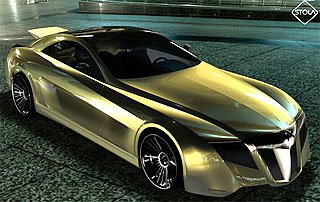
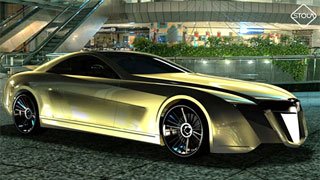 The Phalcon one-off, sporting a huge falcon on its nose, was imposing under the lights in the Geneva show hall. On closer examination, it was apparent that it was a slightly altered version of the Maybach Exelero, which Stola helped German tiremaker Fulda develop as a one-off for the Geneva show two years ago. The interesting thing is that, although Stola participated in the Exelero project, the car was designed by some university students in Pforzheim in cooperation with Mercedes-Benz.
The Phalcon one-off, sporting a huge falcon on its nose, was imposing under the lights in the Geneva show hall. On closer examination, it was apparent that it was a slightly altered version of the Maybach Exelero, which Stola helped German tiremaker Fulda develop as a one-off for the Geneva show two years ago. The interesting thing is that, although Stola participated in the Exelero project, the car was designed by some university students in Pforzheim in cooperation with Mercedes-Benz.
Phalcon is based around a Brabus platform, meaning that ultimately it is derived from a Mercedes-Benz. Power comes from a Brabus-tuned V12 biturbo, churning out 750 horsepower and 1,003 pound-feet of torque. No wonder claimed top speed is 200 mph.
Stola plans to have a run of 25 cars, each tailored to the tastes of individual customers.

 The Phalcon one-off, sporting a huge falcon on its nose, was imposing under the lights in the Geneva show hall. On closer examination, it was apparent that it was a slightly altered version of the Maybach Exelero, which Stola helped German tiremaker Fulda develop as a one-off for the Geneva show two years ago. The interesting thing is that, although Stola participated in the Exelero project, the car was designed by some university students in Pforzheim in cooperation with Mercedes-Benz.
The Phalcon one-off, sporting a huge falcon on its nose, was imposing under the lights in the Geneva show hall. On closer examination, it was apparent that it was a slightly altered version of the Maybach Exelero, which Stola helped German tiremaker Fulda develop as a one-off for the Geneva show two years ago. The interesting thing is that, although Stola participated in the Exelero project, the car was designed by some university students in Pforzheim in cooperation with Mercedes-Benz.Phalcon is based around a Brabus platform, meaning that ultimately it is derived from a Mercedes-Benz. Power comes from a Brabus-tuned V12 biturbo, churning out 750 horsepower and 1,003 pound-feet of torque. No wonder claimed top speed is 200 mph.
Stola plans to have a run of 25 cars, each tailored to the tastes of individual customers.
Sunday, March 11, 2007
VIDEO: 2008 BMW M3 Concept from Geneva Auto Show
Photo Montage Video of the much anticipated 2008 BMW M3 from the Geneva Auto Show
Geneva Auto Show: DigitalChip's V12 quad-turbo R34 GT-R
During our time in the grand metropolis of Geneva, we had every intention of spending some quality time at the tuner expo adjacent to the main halls. But with all that was going on, time was limited, and aside from the R8-ified TT and those kick ass chairs that our friend Paukert found, there wasn't too much of interest. Then we came across this.
The European firm DigitalChip didn't think that the stock RB in their shop's Skyline R34 GT-R had enough juice, so they yanked the stock mill and replaced it with a 7L V12. And then – just for kicks – bolted on four turbos. The result: 1000+ HP, 1000 NM of torque, a 0-60 time of 2.9 seconds and a quarter mile trap speed at the low end of nine seconds. Complete with carbon-ceramic brakes (381mm front, 355mm rear), 13x18-inch wheels and weighing a paltry 2,200 pounds, the GTR "Unlimited" can reach a maximum speed of 220 MPH and seems to be the highlight of several shows and tuner magazines abroad.
Unfortunately, we were on our way out the door when we snapped these few pics, so no one was on hand to answer questions or pop the hood. We would've given our last franc just to sit in the driver's seat, but alas, time wasn't on our side. Frankfurt's coming up at the end of the year, so maybe we'll have a second chance to see the "Unlimited" up close again.
source: autocult
Saturday, March 10, 2007
Tata Elegante
GENEVA — While Indian automaker Tata plans an ultra-cheap $1,700 car, it has also been busy upgrading its midsize family-oriented models, the Indigo hatch and the Indica sedan. The Elegante concept unveiled at the Geneva auto show previewed a new version of the Indica.
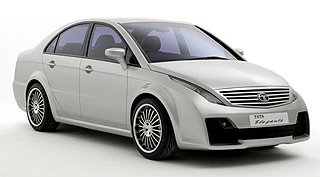 The Elegante is the first preview of Tata's all-new sedan. It was conceived with a range of 1.4-liter to 2.0-liter four-cylinder gasoline and diesel engines in mind. Tata also mentioned the possibility of a V6 gas engine and Fiat-sourced common-rail direct-injection turbodiesels.
The Elegante is the first preview of Tata's all-new sedan. It was conceived with a range of 1.4-liter to 2.0-liter four-cylinder gasoline and diesel engines in mind. Tata also mentioned the possibility of a V6 gas engine and Fiat-sourced common-rail direct-injection turbodiesels.
The production version of the Elegante, which is not as elegant as its name suggests, will be introduced later this year as a sedan, to be followed by a hatch. These models will be bigger than their predecessors.
Tata is now trying to widen its portfolio. In addition to the Indigo/Indica line, there are various off-roaders and pickup trucks, including the minuscule 1-ton Ace, which has been a runaway success in rural India.
 The Elegante is the first preview of Tata's all-new sedan. It was conceived with a range of 1.4-liter to 2.0-liter four-cylinder gasoline and diesel engines in mind. Tata also mentioned the possibility of a V6 gas engine and Fiat-sourced common-rail direct-injection turbodiesels.
The Elegante is the first preview of Tata's all-new sedan. It was conceived with a range of 1.4-liter to 2.0-liter four-cylinder gasoline and diesel engines in mind. Tata also mentioned the possibility of a V6 gas engine and Fiat-sourced common-rail direct-injection turbodiesels.The production version of the Elegante, which is not as elegant as its name suggests, will be introduced later this year as a sedan, to be followed by a hatch. These models will be bigger than their predecessors.
Tata is now trying to widen its portfolio. In addition to the Indigo/Indica line, there are various off-roaders and pickup trucks, including the minuscule 1-ton Ace, which has been a runaway success in rural India.
Mansory Conquistador
GENEVA — You have to ask yourself: Can you picture someone in the mold of Hernándo Cortés or Francisco Pizarro behind the wheel of the behemoth Mansory Conquistador? The answer is, of course, a resounding yes.
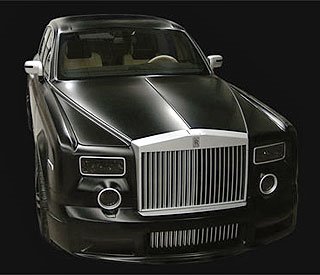
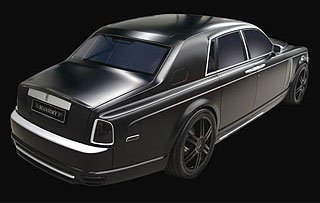 The Conquistador, the German tuning house's latest riff on the Rolls Royce Phantom, is a doff of the helmet to the Spanish soldiers and adventurers who conquered South and Central America in the 16th century. Or maybe the designers just liked the Procol Harum song of the same name. Anyway, the customized Rolls made its world debut at the Geneva auto show on Thursday.
The Conquistador, the German tuning house's latest riff on the Rolls Royce Phantom, is a doff of the helmet to the Spanish soldiers and adventurers who conquered South and Central America in the 16th century. Or maybe the designers just liked the Procol Harum song of the same name. Anyway, the customized Rolls made its world debut at the Geneva auto show on Thursday.
Key features are a shadow black paint job, massive 24-inch wheels, a new front spoiler with integrated LED daytime running lights, and new side skirts. The mirrors get integrated flasher lights, and the tail is decked out with a trunk lid spoiler. High-performance Brembo brakes are part of the package.
Mansory said it modified the engine, which now churns out 490 horsepower and 575 pound-feet of torque at 3,920 rpm. The Conquistador has a top speed of 168 mph.
In the cabin, passengers can regulate the transparency of the windows via remote control. Other interior upgrades include carbon-fiber trim, ambient lighting and rear tables with integrated multimedia monitors.

 The Conquistador, the German tuning house's latest riff on the Rolls Royce Phantom, is a doff of the helmet to the Spanish soldiers and adventurers who conquered South and Central America in the 16th century. Or maybe the designers just liked the Procol Harum song of the same name. Anyway, the customized Rolls made its world debut at the Geneva auto show on Thursday.
The Conquistador, the German tuning house's latest riff on the Rolls Royce Phantom, is a doff of the helmet to the Spanish soldiers and adventurers who conquered South and Central America in the 16th century. Or maybe the designers just liked the Procol Harum song of the same name. Anyway, the customized Rolls made its world debut at the Geneva auto show on Thursday.Key features are a shadow black paint job, massive 24-inch wheels, a new front spoiler with integrated LED daytime running lights, and new side skirts. The mirrors get integrated flasher lights, and the tail is decked out with a trunk lid spoiler. High-performance Brembo brakes are part of the package.
Mansory said it modified the engine, which now churns out 490 horsepower and 575 pound-feet of torque at 3,920 rpm. The Conquistador has a top speed of 168 mph.
In the cabin, passengers can regulate the transparency of the windows via remote control. Other interior upgrades include carbon-fiber trim, ambient lighting and rear tables with integrated multimedia monitors.
Geneva Auto Show: Kia ex_cee'd
We know, a Korean cabrio-convertible - especially one in Essex-stiletto white and with such a ridiculously convoluted name - should be a prime target for some lazy gags.
But we've been impressed by the standard cee'd, and we have to admit we rather like this. It's a concept version of the Korean manufacturer's small hatch, styled by Peter Schreyer and called - ready? - the ex_cee'd.

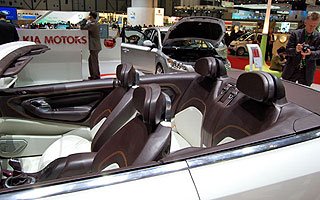 Instead of the ubiquitous folding hard-top seen on the VW Eos et al, the ex_cee'd gets a powered fabric roof. Dispensing of the necessity of wedging a roof-shaped piece of metal behind the rear seats gives the ex_cee'd a much less convoluted profile than most current C+Cs, and we love those ultra-bling 19-inch alloys too.
Instead of the ubiquitous folding hard-top seen on the VW Eos et al, the ex_cee'd gets a powered fabric roof. Dispensing of the necessity of wedging a roof-shaped piece of metal behind the rear seats gives the ex_cee'd a much less convoluted profile than most current C+Cs, and we love those ultra-bling 19-inch alloys too.
Of course, whether it looks anything like as good when (or indeed if) it reaches production remains to be seen, but it's all good stuff from Kia.
At the more practical end of the scale, Kia has also been showing off the cee'd SW, the estate version of the cee'd. OK, it's about as sexy as a girder, but with decent loadspace and that cracking seven-year warranty it should be a sensible buy when it goes on sale early this autumn.
source: topgear
But we've been impressed by the standard cee'd, and we have to admit we rather like this. It's a concept version of the Korean manufacturer's small hatch, styled by Peter Schreyer and called - ready? - the ex_cee'd.

 Instead of the ubiquitous folding hard-top seen on the VW Eos et al, the ex_cee'd gets a powered fabric roof. Dispensing of the necessity of wedging a roof-shaped piece of metal behind the rear seats gives the ex_cee'd a much less convoluted profile than most current C+Cs, and we love those ultra-bling 19-inch alloys too.
Instead of the ubiquitous folding hard-top seen on the VW Eos et al, the ex_cee'd gets a powered fabric roof. Dispensing of the necessity of wedging a roof-shaped piece of metal behind the rear seats gives the ex_cee'd a much less convoluted profile than most current C+Cs, and we love those ultra-bling 19-inch alloys too.Of course, whether it looks anything like as good when (or indeed if) it reaches production remains to be seen, but it's all good stuff from Kia.
At the more practical end of the scale, Kia has also been showing off the cee'd SW, the estate version of the cee'd. OK, it's about as sexy as a girder, but with decent loadspace and that cracking seven-year warranty it should be a sensible buy when it goes on sale early this autumn.
source: topgear
Geneva show: Mazda 2 and Mazda Hakaze
The Mazda2 has always provided all the excitement of endurance lawn bowls, but we're much more enamoured with this new one, unveiled in Geneva. Based on the same platform as the next-generation Ford Fiesta, the Mazda2 will be launched with two petrol engines - a 1.3-litre version with 74bhp or 83bhp and a hotter 1.5-litre iteration producing 102bhp.
It's not bad looking by utilitarian city car standards, having obviously picked up some of the hyper-swoopy styling from the weird concepts that Mazda has been rolling out recently.
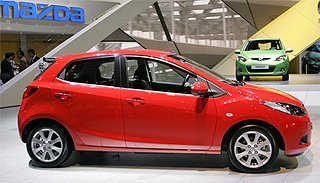 Speaking of weird concepts, Mazda hasn't disappointed with the crazy scissor-doored Hakaze. Based on the same trippy philosophy of 'natural flow lines' as the Ryuga concept we saw in Detroit, it's ostensibly an SUV in the same vein as the Nissan Qashqai.
Speaking of weird concepts, Mazda hasn't disappointed with the crazy scissor-doored Hakaze. Based on the same trippy philosophy of 'natural flow lines' as the Ryuga concept we saw in Detroit, it's ostensibly an SUV in the same vein as the Nissan Qashqai.
However, it's much more coupe-like in appearance, with great swathes of glass on top and all manner of weird rubberised surfaces inside the cabin.
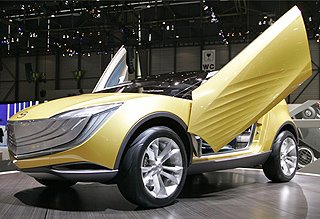
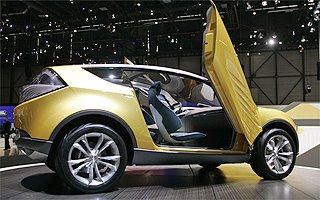 While that might all reek of unfeasible concept madness, Mazda says the Hakaze isn't far off production reality. Based on the same floorpan as the Ford Focus and Volvo C30, we could see something similar to the Hakaze on our roads within the next year or so.
While that might all reek of unfeasible concept madness, Mazda says the Hakaze isn't far off production reality. Based on the same floorpan as the Ford Focus and Volvo C30, we could see something similar to the Hakaze on our roads within the next year or so.
It's not bad looking by utilitarian city car standards, having obviously picked up some of the hyper-swoopy styling from the weird concepts that Mazda has been rolling out recently.
 Speaking of weird concepts, Mazda hasn't disappointed with the crazy scissor-doored Hakaze. Based on the same trippy philosophy of 'natural flow lines' as the Ryuga concept we saw in Detroit, it's ostensibly an SUV in the same vein as the Nissan Qashqai.
Speaking of weird concepts, Mazda hasn't disappointed with the crazy scissor-doored Hakaze. Based on the same trippy philosophy of 'natural flow lines' as the Ryuga concept we saw in Detroit, it's ostensibly an SUV in the same vein as the Nissan Qashqai.However, it's much more coupe-like in appearance, with great swathes of glass on top and all manner of weird rubberised surfaces inside the cabin.

 While that might all reek of unfeasible concept madness, Mazda says the Hakaze isn't far off production reality. Based on the same floorpan as the Ford Focus and Volvo C30, we could see something similar to the Hakaze on our roads within the next year or so.
While that might all reek of unfeasible concept madness, Mazda says the Hakaze isn't far off production reality. Based on the same floorpan as the Ford Focus and Volvo C30, we could see something similar to the Hakaze on our roads within the next year or so.
Paragon Artega GT
GENEVA — German automotive supplier Paragon unveiled a new rolling showcase of its capabilities at the Geneva auto show. Its Artega GT coupe was engineered entirely in-house and is backed by industry heavyweights.
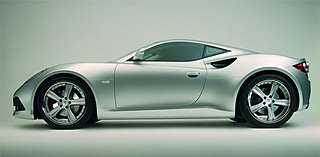
 Klaus-Dieter Frers, CEO of Paragon, looked very pleased at the Geneva show. His Artega was penned by former Aston designer-turned coachbuilder and industrial stylist Henrik Fisker, and it attracted the serious attention of a few carmakers at the show who were particularly attracted to the new dashboard layout. Paragon supplies air-conditioning systems, instrumentation and other components to the auto industry, and it incorporated all its knowledge in the Artega.
Klaus-Dieter Frers, CEO of Paragon, looked very pleased at the Geneva show. His Artega was penned by former Aston designer-turned coachbuilder and industrial stylist Henrik Fisker, and it attracted the serious attention of a few carmakers at the show who were particularly attracted to the new dashboard layout. Paragon supplies air-conditioning systems, instrumentation and other components to the auto industry, and it incorporated all its knowledge in the Artega.
The Artega is powered by a 300-horsepower 3.6-liter Volkswagen engine that propels the sleek coupe to a claimed 167-plus mph. Apart from the engine, all components were built in-house, including the aluminum space frame and the six-speed direct-shift gearbox.
Paragon hired Karl-Heinz Kalbfell, who has previously worked for BMW, Rolls-Royce, Fiat and other carmakers. His presence highlighted Artega's debut and provided even more publicity opportunities for the company.
There'll be just a limited run of Artegas produced. Deliveries will start next summer, and final specifications will be revealed closer to the on-sale date.

 Klaus-Dieter Frers, CEO of Paragon, looked very pleased at the Geneva show. His Artega was penned by former Aston designer-turned coachbuilder and industrial stylist Henrik Fisker, and it attracted the serious attention of a few carmakers at the show who were particularly attracted to the new dashboard layout. Paragon supplies air-conditioning systems, instrumentation and other components to the auto industry, and it incorporated all its knowledge in the Artega.
Klaus-Dieter Frers, CEO of Paragon, looked very pleased at the Geneva show. His Artega was penned by former Aston designer-turned coachbuilder and industrial stylist Henrik Fisker, and it attracted the serious attention of a few carmakers at the show who were particularly attracted to the new dashboard layout. Paragon supplies air-conditioning systems, instrumentation and other components to the auto industry, and it incorporated all its knowledge in the Artega.The Artega is powered by a 300-horsepower 3.6-liter Volkswagen engine that propels the sleek coupe to a claimed 167-plus mph. Apart from the engine, all components were built in-house, including the aluminum space frame and the six-speed direct-shift gearbox.
Paragon hired Karl-Heinz Kalbfell, who has previously worked for BMW, Rolls-Royce, Fiat and other carmakers. His presence highlighted Artega's debut and provided even more publicity opportunities for the company.
There'll be just a limited run of Artegas produced. Deliveries will start next summer, and final specifications will be revealed closer to the on-sale date.
Lada C-Class Concept Coupe
GENEVA — Hot on the heels of a new deal with Canadian supplier and engineering giant Magna, Russian company AvtoVAZ, manufacturer of Lada cars, showed a compact hatch at the Geneva auto show. Called the C-Class Concept Coupe, it may preview the look of a brand-new Lada.
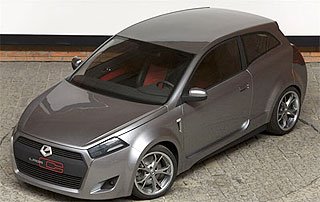
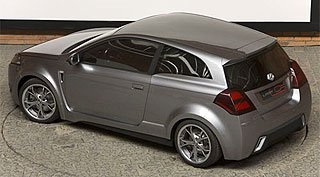 On the surface, the situation at AvtoVAZ, the dominant automobile producer in Russia, looks rosy — but major products are hopelessly outdated, new ones trickle in very slowly, and to complicate matters, the Russian government is slowly introducing new emission control rules both for the cars themselves and for the plants producing them.
On the surface, the situation at AvtoVAZ, the dominant automobile producer in Russia, looks rosy — but major products are hopelessly outdated, new ones trickle in very slowly, and to complicate matters, the Russian government is slowly introducing new emission control rules both for the cars themselves and for the plants producing them.
Indirectly government controlled, AvtoVAZ hooked up with Magna late last year. Magna will help the Russian company develop a brand-new, up-to-date model for introduction in 2009. According to rumors, it will be produced using the latest technology, with assistance from Western supplier companies. The styling mock-up shown at Geneva is basically a starting point, a sort of demonstration to show potential partners where the company would like to go.

 On the surface, the situation at AvtoVAZ, the dominant automobile producer in Russia, looks rosy — but major products are hopelessly outdated, new ones trickle in very slowly, and to complicate matters, the Russian government is slowly introducing new emission control rules both for the cars themselves and for the plants producing them.
On the surface, the situation at AvtoVAZ, the dominant automobile producer in Russia, looks rosy — but major products are hopelessly outdated, new ones trickle in very slowly, and to complicate matters, the Russian government is slowly introducing new emission control rules both for the cars themselves and for the plants producing them.Indirectly government controlled, AvtoVAZ hooked up with Magna late last year. Magna will help the Russian company develop a brand-new, up-to-date model for introduction in 2009. According to rumors, it will be produced using the latest technology, with assistance from Western supplier companies. The styling mock-up shown at Geneva is basically a starting point, a sort of demonstration to show potential partners where the company would like to go.
Friday, March 9, 2007
PSA Walks Away From Proton, Chrysler
GENEVA — PSA Peugeot Citroën has withdrawn from negotiations to acquire or form an alliance with troubled Malaysian automaker Proton, which owns Lotus. Further, PSA executives say they are not interested in acquiring the Chrysler Group from DaimlerChrysler, throwing more cold water on speculation that the French carmaker might be planning a return to North America.
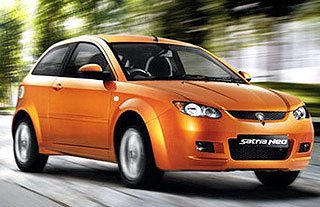 In a media session at the Geneva auto show, PSA Chief Executive Christian Streiff said the company does not "have time" to look at Chrysler while it is focused on improving profits and quality. "To launch [a bid] now would be such a distraction of effort that it isn't possible," Strieff told reporters. "I do not think we will conclude another industrial alliance."
In a media session at the Geneva auto show, PSA Chief Executive Christian Streiff said the company does not "have time" to look at Chrysler while it is focused on improving profits and quality. "To launch [a bid] now would be such a distraction of effort that it isn't possible," Strieff told reporters. "I do not think we will conclude another industrial alliance."
The company announced Monday that it was breaking off talks with Proton after more than six months of discussions about a possible alliance or acquisition, including a feasibility study on joint production and platform-sharing in Malaysia. An official statement said: "An in-depth study of the automobile market and the economic conditions for co-producing vehicles with Proton concluded that the conditions for the project's success were not present. PSA Peugeot Citroën has informed Proton of its decision not to follow up on the study."
PSA continues to support a number of alliances around the globe, with such automakers as BMW, Dongfeng, Ford, Fiat, Mitsubishi and Toyota.
Proton, meanwhile, continues to discuss the possibility of a tie-up with Volkswagen, but local press reports from Kuala Lumpur say the talks are not going well. VW reportedly wants to control local manufacturing operations, but does not want to take a majority interest in the parent company, which currently is controlled by the Malaysian government.
General Motors also has expressed an interest in Proton, but the nature and status of that interest are unknown.
 In a media session at the Geneva auto show, PSA Chief Executive Christian Streiff said the company does not "have time" to look at Chrysler while it is focused on improving profits and quality. "To launch [a bid] now would be such a distraction of effort that it isn't possible," Strieff told reporters. "I do not think we will conclude another industrial alliance."
In a media session at the Geneva auto show, PSA Chief Executive Christian Streiff said the company does not "have time" to look at Chrysler while it is focused on improving profits and quality. "To launch [a bid] now would be such a distraction of effort that it isn't possible," Strieff told reporters. "I do not think we will conclude another industrial alliance."The company announced Monday that it was breaking off talks with Proton after more than six months of discussions about a possible alliance or acquisition, including a feasibility study on joint production and platform-sharing in Malaysia. An official statement said: "An in-depth study of the automobile market and the economic conditions for co-producing vehicles with Proton concluded that the conditions for the project's success were not present. PSA Peugeot Citroën has informed Proton of its decision not to follow up on the study."
PSA continues to support a number of alliances around the globe, with such automakers as BMW, Dongfeng, Ford, Fiat, Mitsubishi and Toyota.
Proton, meanwhile, continues to discuss the possibility of a tie-up with Volkswagen, but local press reports from Kuala Lumpur say the talks are not going well. VW reportedly wants to control local manufacturing operations, but does not want to take a majority interest in the parent company, which currently is controlled by the Malaysian government.
General Motors also has expressed an interest in Proton, but the nature and status of that interest are unknown.
Dodge Demon
This curious-looking creature - the car, not the passenger - is the Dodge Demon, an ambitious attempt by the Chrysler Group to produce a lightweight, nimble roadster.
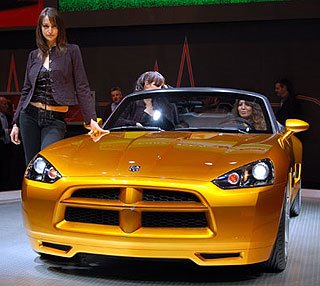
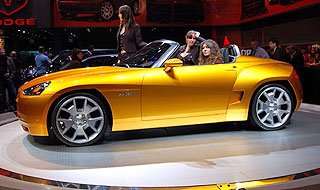 And for a product from the stable of America's brashest, boldest pick-up builder, it's surprisingly petite.
And for a product from the stable of America's brashest, boldest pick-up builder, it's surprisingly petite.
In fact, with the exception of that truck-style crosshair grill, you could be forgiven for mistaking the Demon for a small European roadster.
And that's exactly what Dodge is aiming for. The Demon is similar in size to the Mazda MX-5, and gets a 172bhp 2.4-litre petrol engine powering the rear wheels. There's even a six-speed manual 'box - a sure sign of heavy European influence.
There are plenty in Geneva who are enamoured by the Demon's styling, but we're still a touch unsure. It's a good effort, but it doesn't seem to quite fit together.
We'll withhold final judgment until the Demon makes it to production, though.
Source: topgear

 And for a product from the stable of America's brashest, boldest pick-up builder, it's surprisingly petite.
And for a product from the stable of America's brashest, boldest pick-up builder, it's surprisingly petite.In fact, with the exception of that truck-style crosshair grill, you could be forgiven for mistaking the Demon for a small European roadster.
And that's exactly what Dodge is aiming for. The Demon is similar in size to the Mazda MX-5, and gets a 172bhp 2.4-litre petrol engine powering the rear wheels. There's even a six-speed manual 'box - a sure sign of heavy European influence.
There are plenty in Geneva who are enamoured by the Demon's styling, but we're still a touch unsure. It's a good effort, but it doesn't seem to quite fit together.
We'll withhold final judgment until the Demon makes it to production, though.
Source: topgear
Volkswagen Phaeton
GENEVA — Americans never could warm up to the Volkswagen Phaeton, the German automaker's over-the-top luxury sedan. The Phaeton left the U.S. market in 2006, a victim of a negative image and a too-expensive price tag. So when VW rolled out its face-lifted Phaeton on Tuesday at the Geneva auto show, it was clear that the U.S. crowd will have to be content with admiring it from afar.
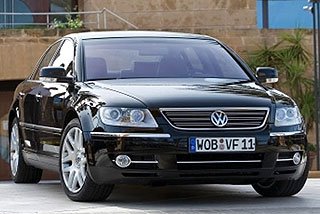 The redone Phaeton goes on sale in Europe this summer. Key changes include a new face that brings the Phaeton more in line with the VW family look. The Geneva show also marked the debut of a new 3.0-liter V6 TDI engine for the Phaeton that delivers 234 horsepower — a 13-hp increase over the previous V6 TDI engine. VW noted that the new common-rail direct-injection engine meets Euro V emissions standards ahead of the 2009 deadline.
The redone Phaeton goes on sale in Europe this summer. Key changes include a new face that brings the Phaeton more in line with the VW family look. The Geneva show also marked the debut of a new 3.0-liter V6 TDI engine for the Phaeton that delivers 234 horsepower — a 13-hp increase over the previous V6 TDI engine. VW noted that the new common-rail direct-injection engine meets Euro V emissions standards ahead of the 2009 deadline.
The Phaeton lineup includes three gas engines: a 237-hp 3.2-liter V6, a 330-hp 4.2-liter V8 and a 444-hp 6.0-liter W12.
The Phaeton also gets new bi-xenon adaptive front headlights, as well as a "front and side scan system" that automatically brings the car to a complete stop in "extreme circumstances." The system checks the area beside the Phaeton for obstacles it may encounter during lane changes. The Phaeton also gets two new 19-inch alloy wheel designs, simpler controls for the entertainment system and a new Bluetooth-enabled phone.
 The redone Phaeton goes on sale in Europe this summer. Key changes include a new face that brings the Phaeton more in line with the VW family look. The Geneva show also marked the debut of a new 3.0-liter V6 TDI engine for the Phaeton that delivers 234 horsepower — a 13-hp increase over the previous V6 TDI engine. VW noted that the new common-rail direct-injection engine meets Euro V emissions standards ahead of the 2009 deadline.
The redone Phaeton goes on sale in Europe this summer. Key changes include a new face that brings the Phaeton more in line with the VW family look. The Geneva show also marked the debut of a new 3.0-liter V6 TDI engine for the Phaeton that delivers 234 horsepower — a 13-hp increase over the previous V6 TDI engine. VW noted that the new common-rail direct-injection engine meets Euro V emissions standards ahead of the 2009 deadline.The Phaeton lineup includes three gas engines: a 237-hp 3.2-liter V6, a 330-hp 4.2-liter V8 and a 444-hp 6.0-liter W12.
The Phaeton also gets new bi-xenon adaptive front headlights, as well as a "front and side scan system" that automatically brings the car to a complete stop in "extreme circumstances." The system checks the area beside the Phaeton for obstacles it may encounter during lane changes. The Phaeton also gets two new 19-inch alloy wheel designs, simpler controls for the entertainment system and a new Bluetooth-enabled phone.
Ferrari Revs Up for Launch of New Model at Frankfurt Show
GENEVA — For those who are wondering why Ferrari is a relatively quiet presence at the Geneva auto show, the answer became clear on Wednesday as the Italian supercar maker confirmed that it is hustling to launch a new model at the Frankfurt auto show in the fall.
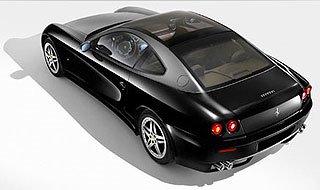 Fiat Chairman Luca Cordero di Montezemolo told Reuters that the new model, which will be based on the F430, the company's most popular car, is in the works. "It is a new model on which there's been key research on weight reduction, performance obtained from Ferrari's experience in [Formula 1] competitions and safety," the company said in a statement.
Fiat Chairman Luca Cordero di Montezemolo told Reuters that the new model, which will be based on the F430, the company's most popular car, is in the works. "It is a new model on which there's been key research on weight reduction, performance obtained from Ferrari's experience in [Formula 1] competitions and safety," the company said in a statement.
He also said there are no plans to carry out an IPO for Ferrari.
Ferrari's news from Geneva has been relatively low-key, centering on such things as color and trim changes and new tech features for the 612 Scaglietti.
Ferrari has relaunched 10 historic exterior colors for the 612 Scaglietti, after conducting what it describes as "meticulous research in the company archive." The Italian supercar manufacturer used the occasion of the 2007 Geneva Auto Show to unveil the colors and to introduce new features for the Scaglietti, as well as roll out its Ferrari Financial Services.
The financial services arm is designed to offer "exclusive financing for historic models, competition cars and even Formula 1 single-seaters," the automaker said.
The historic colors are: Avio, Avorio, Azzurro, Blu Scozia, Celeste, Grigio Ferro, Grigio Medio, Grigio Scuro, Verde Abetone and Vinaccia.
Ferrari also introduced a new Bose 2 DIN radio navigator for the 612 Scaglietti. The system is available in the U.S. market and combines radio, audio and video DVD, Bluetooth and satellite radio. A TV tuner and a rear parking camera are also part of the system.
The Italian supercar maker also introduced a new satellite anti-theft system integrated with the car alarm for main European markets. This system includes a GPS antenna and a transponder key.
Ferrari also noted that it has developed a new car configurator that will allow its online customers to simulate their dream Scaglietti. "There is an almost an infinite number of configurations possible for all the models in the range," it said. The personalization program is accessed at the Ferrari Owners' Web site.
 Fiat Chairman Luca Cordero di Montezemolo told Reuters that the new model, which will be based on the F430, the company's most popular car, is in the works. "It is a new model on which there's been key research on weight reduction, performance obtained from Ferrari's experience in [Formula 1] competitions and safety," the company said in a statement.
Fiat Chairman Luca Cordero di Montezemolo told Reuters that the new model, which will be based on the F430, the company's most popular car, is in the works. "It is a new model on which there's been key research on weight reduction, performance obtained from Ferrari's experience in [Formula 1] competitions and safety," the company said in a statement.He also said there are no plans to carry out an IPO for Ferrari.
Ferrari's news from Geneva has been relatively low-key, centering on such things as color and trim changes and new tech features for the 612 Scaglietti.
Ferrari has relaunched 10 historic exterior colors for the 612 Scaglietti, after conducting what it describes as "meticulous research in the company archive." The Italian supercar manufacturer used the occasion of the 2007 Geneva Auto Show to unveil the colors and to introduce new features for the Scaglietti, as well as roll out its Ferrari Financial Services.
The financial services arm is designed to offer "exclusive financing for historic models, competition cars and even Formula 1 single-seaters," the automaker said.
The historic colors are: Avio, Avorio, Azzurro, Blu Scozia, Celeste, Grigio Ferro, Grigio Medio, Grigio Scuro, Verde Abetone and Vinaccia.
Ferrari also introduced a new Bose 2 DIN radio navigator for the 612 Scaglietti. The system is available in the U.S. market and combines radio, audio and video DVD, Bluetooth and satellite radio. A TV tuner and a rear parking camera are also part of the system.
The Italian supercar maker also introduced a new satellite anti-theft system integrated with the car alarm for main European markets. This system includes a GPS antenna and a transponder key.
Ferrari also noted that it has developed a new car configurator that will allow its online customers to simulate their dream Scaglietti. "There is an almost an infinite number of configurations possible for all the models in the range," it said. The personalization program is accessed at the Ferrari Owners' Web site.
Bertone Barchetta Concept
GENEVA — The legendary Italian design studio Bertone introduced its Barchetta concept at the Geneva auto show, with a design that harks back to happier times in the company's history.
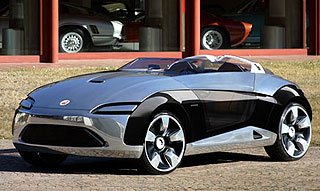
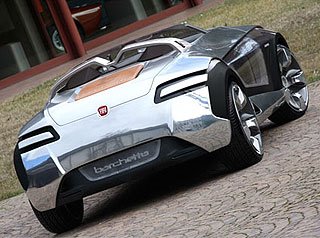 Giovanni Bertone set up a body shop in Turin in 1912. Nuccio, his son, transformed the company into a styling studio and then expanded into manufacturing. Nuccio died in 1997 and the company has been losing important clients during the last couple of years, increasingly relying on work from China to keep afloat.
Giovanni Bertone set up a body shop in Turin in 1912. Nuccio, his son, transformed the company into a styling studio and then expanded into manufacturing. Nuccio died in 1997 and the company has been losing important clients during the last couple of years, increasingly relying on work from China to keep afloat.
But here in Geneva, Bertone showed the old spirit is still alive with the Barchetta. The barchetta (Italian for "small boat") is a typical Italian body style, sitting somewhere between a windshield-less spyder and a roadster. Barchettas were very popular in Italy during the late 1940s and '50s; the first Ferraris were barchettas.
Nuccio also created a barchetta off the minuscule Fiat 500 in 1947 for his personal use. This prototype was the inspiration for the current Barchetta concept. This one is based on the recently introduced Fiat Panda 100 HP, a scorching version of the Italian supermini.
The 151.7-inch Barchetta has Lamborghini-style suicide doors, LED front lights and a shiny aluminum body — all traits that make it an interesting showcar. Inside, the two seats are fixed, but the dash is adjustable.

 Giovanni Bertone set up a body shop in Turin in 1912. Nuccio, his son, transformed the company into a styling studio and then expanded into manufacturing. Nuccio died in 1997 and the company has been losing important clients during the last couple of years, increasingly relying on work from China to keep afloat.
Giovanni Bertone set up a body shop in Turin in 1912. Nuccio, his son, transformed the company into a styling studio and then expanded into manufacturing. Nuccio died in 1997 and the company has been losing important clients during the last couple of years, increasingly relying on work from China to keep afloat.But here in Geneva, Bertone showed the old spirit is still alive with the Barchetta. The barchetta (Italian for "small boat") is a typical Italian body style, sitting somewhere between a windshield-less spyder and a roadster. Barchettas were very popular in Italy during the late 1940s and '50s; the first Ferraris were barchettas.
Nuccio also created a barchetta off the minuscule Fiat 500 in 1947 for his personal use. This prototype was the inspiration for the current Barchetta concept. This one is based on the recently introduced Fiat Panda 100 HP, a scorching version of the Italian supermini.
The 151.7-inch Barchetta has Lamborghini-style suicide doors, LED front lights and a shiny aluminum body — all traits that make it an interesting showcar. Inside, the two seats are fixed, but the dash is adjustable.
Subscribe to:
Posts (Atom)

